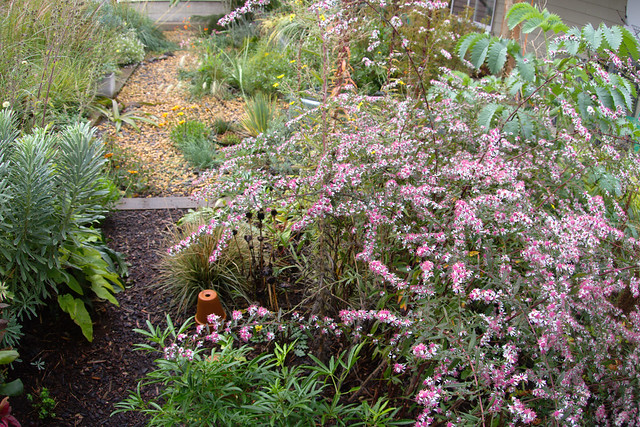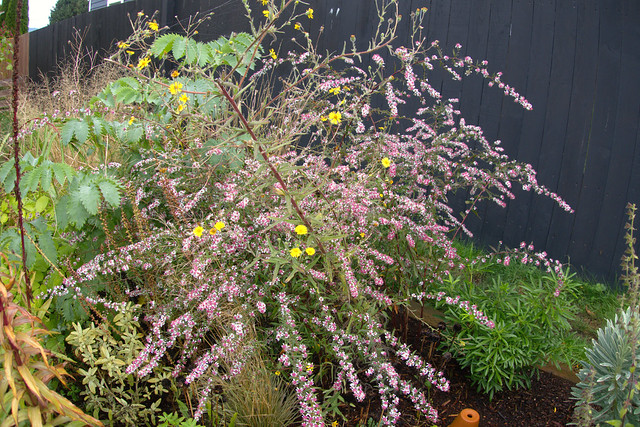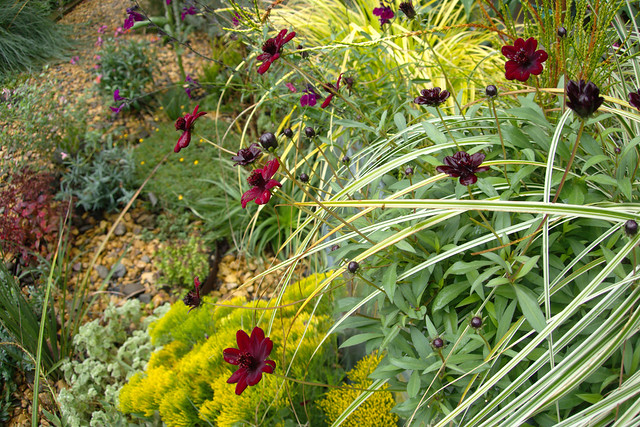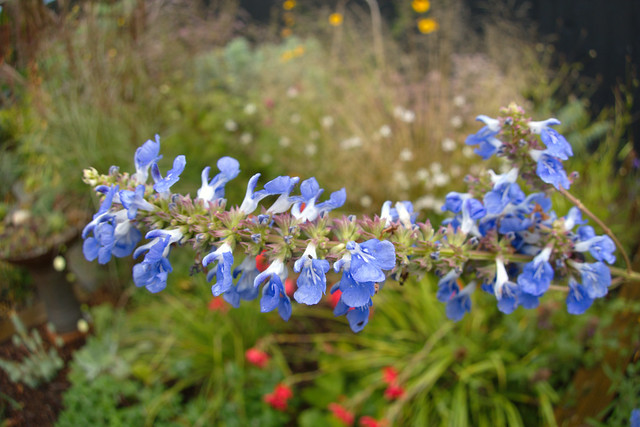I’ve been talking up all summer the two Aster lateriflorus var. horizontalis varieties in my garden (‘Prince’ and ‘Lady in Black’). Rich dark leaves early in the season suspended on a light framework that doesn’t overwhelm neighbors. I’m not saying the Sept/October blooms are incidental, but they are an additionally winning, late-season virtue of an all-around, very good plant. Wind and rain do not beat these plants down. Right now I wish I had room for a much larger planting of them — so good with grasses.
If I had to choose, my preference would be ‘Lady in Black’ for its open, arching habit of growth. Spittle bugs were all over early spring growth, so I cut quite a bit off to rid the plant of the pests — not sure if they’re damaging but they are disgusting! Even with that spring cutback it makes sizeable growth up to blooming size of approx 4 feet.
Special mention to those plants whose images refused to upload: The wallflowers manage to handle the 4-month dry season as well as the cold, rainy rest of the year (Erysimum ‘Winter Orchid’); Emilia javanica, an annual with tall stems topped with small, brilliant, orange thistle brushes, nice with Pennisetum villosum, both gracefully handling a rainy October; and Parahebe catarractae, a flawless little foreground shrub, evergreen, covered in tiny white flowers now, as it has been on and off all summer.
And last but not least, the tall annual Persicaria orientalis in the vegetable garden leaning on the bean trellis. Lettuce, beans, peas, and zucchini have been stellar this summer on the coast.
More Bloom Day reports for October can be found here.












I have to try growing Chrysanthemums at some point, one of the interesting spider types that has to be obtained by mail order because only puny, boring varieties are sold in garden centers here, meant to be put out on a doorstep as Thanksgiving decorations, then tossed out immediately afterwards. I need to look at Persicaria orientalis too – I love its rich jewel color.
Those chocolate cosmos are dreamy! I should start seeds next year…
Love the asters and the Anisodontea. Looks very similar to Abutilon. Fall really is a wonderful season. In some ways it’s more relaxed and the plants don’t compete with each other as much for your attention. Not sure why people purchase mum’s in the Fall when they can grow garden varieties that offer so much more
Lovely!
Gotta love late season asters. I’ve got the Prince, but not Lady in Black. I agree, Lady in Black is more alluring by far. We get spittlebugs on everything in spring. Never thought to cut plants back to help reduce the population. I’ve always just sort of let them be, unless it’s a new seedling of something, and don’t usually see too much damage.
Your mums look stunning! I can’t seem to pull them off here, too dry I guess.
@Kris, FYI, I brought these mums up from zone 10 — they bloomed there as well. OTOH, I could not get P. orientalis to bloom in our dry summers. Maybe in your cutting garden with lots of water.
@Loree, I’d just grab plants if I were you — they seem to be everywhere in spring/summer, even here on our remote coast, because they do so well. Plants in the ground at the Wonder Garden were epic all summer.
@Elaine, you’re right, there is a nodding, abutilon quality to anisodontea, and they both share the trait of growing quite large here in zone 8b at the coast!
@Hoov, thank goodness we can control the “lovely” in our little worlds!
@Jerry, I’ve been working on the frontyard garden and am seriously considering a big sweep of LIB with silver spike grass, and I rarely forego the opportunity to plant lots of different plants, but I might make an exception in this case.
@Tracy, the mums are better here in zone 8b than they were down in dry zone 10, but I bet they might work if treated like vegetables or grown in a cutting garden, i.e. lot of supplemental water, especially near fall bloom. These really came out of nowhere when the rains returned in October.